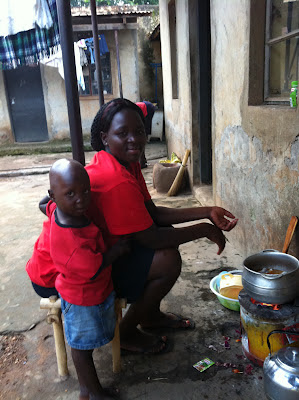 |
| A home in the town/city |
 |
| Huts in the villages |
 |
| Students and parents walk a LONG way to get to school or work |
 |
| (pictures compliments of Jeff Shimabuku - thanks, Jeff!) |
A huge success and catalyst for critical thinking
came with the home visits I did with Alice. I mentioned the idea to
her earlier in the term when noting some of the best/most memorable experiences
I had in Japan. For me, it was when I could meet with people in their homes and
have an intimate shared experience. I explained that all Japanese teachers are
required to have at least two home visits per school year with all of their
students. This helps the teacher to understand and get to know the student and
their family situation better and connect with them. I really respect this
concept and can see the value in it, but understand how it might not be
possible in Ugandan schools with the cultural interpretation of the visits and
the sheer number of students. Still, Alice was open to the idea and chose six
students at random from our S1 and S3 classes. The only requirement was that
they had showed some responsibility to ensure that if we set up a time they
would be there. We met with the six students once to explain the idea and then
have them ask their parents, then again after that discussion to confirm which
students were interested. All six accepted our pretense.
I was pumped for this opportunity and was
extremely optimistic about the cross cultural exchange. A lot of walking and
translating was done. A lot of food, snacks, and beverages were consumed and
given back and forth. As I learned about the students’ families and their life
situations, I began to grow less optimistic and feel less hopeful. Out of the
six, five of the students came from families where one or both parents were
deceased. Many families were dealing with land disputes, all had four or more
children, all had financial problems delaying payment of school fees and/or
food on a daily basis, much less new roofs, materials to repair clothes, or a
lighting system one family was working on to ensure the children could read at
night.
After the third home I visited, Alice asked me if
I had noticed any expectations. ‘I’m not quite sure what you mean. What
expectations?’ ‘Expectations of support’… long pause. ‘Like, financial
support?’ Yes, she began to explain. We talked for over an hour about the
reality that when a white person has come to a small town or village with
another Guluan, it has meant they are coming with relief. The result in some
situations has been corruption through the Guluan middle ‘man’ taking the
money/aid, strife within communities as one student/child receives more
attention than another, and/or short term relief without a backup plan when the
money/aid stops. My naive visions of a purely cultural exchange between two
human beings to share stories, games, juice, and emotions was now clouded over
by the vision of me as a walking Ugandan shilling (or a million).
With the next three visits, we made it clear at
the beginning and end of the visit what our intent was, but hearing story after
story of struggles weighted heavily on me. I couldn’t stop the tears from
streaming silently down my cheek as one students’ nearly deaf mother shared
about how her murdered husband had left their family with a new wife and a few
years ago and all of his inheritance and property now went to her. They were
left stripped of land, possessions, monetary support, and dignity. We would not
be playing cards at this home, “cards are games for children. We have no time
for cards,” the mother stated bluntly.
My critical thinking will continue as I dialogue
with peers, mentors, and team teachers on this program about what our role
truly is. How, if at all, can I TRULY help? What, if anything, will TRULY make
a difference in these children’s lives?
 |
| I can't get enough of the babies |
 |
| Cooking - a task that consumes the vast majority of the day |
 |
| I learned a TON about crops and agriculture in the region, to the point that I could name any crop by the leaves growing above ground. Mr. Ritz would be proud. This is a millet, a local favorite. |
 |
| I LOVE beans! |









No comments:
Post a Comment